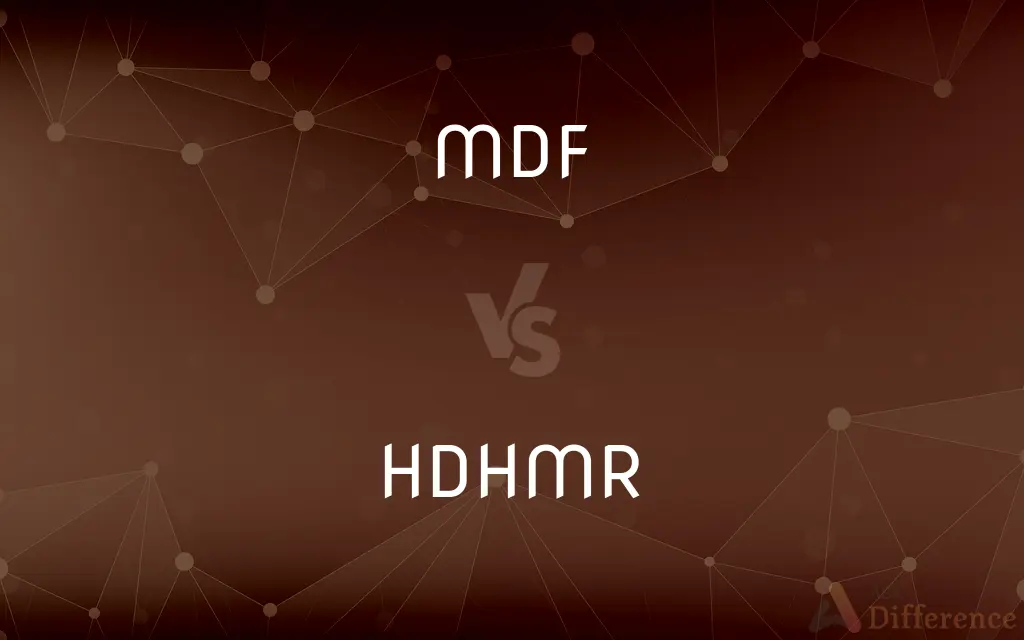MDF vs. HDHMR — What's the Difference?
By Tayyaba Rehman — Published on January 22, 2024
MDF (Medium Density Fiberboard) is an engineered wood product made from wood fibers; HDHMR (High-Density High Moisture Resistance) board is a denser, moisture-resistant MDF variant.

Difference Between MDF and HDHMR
Table of Contents
ADVERTISEMENT
Key Differences
MDF, or Medium Density Fiberboard, is a popular type of engineered wood made by breaking down hardwood or softwood residuals into wood fibers, which are then combined with wax and a resin binder under high temperature and pressure. HDHMR, standing for High-Density High Moisture Resistance, is a specialized type of MDF known for its higher density and enhanced moisture resistance, making it more suitable for areas with high humidity.
In terms of physical properties, MDF is known for its smooth surface, consistency, and easy machinability, which makes it a good choice for furniture and cabinetry. However, HDHMR boards, with their higher density, offer increased strength and durability compared to standard MDF, and are particularly advantageous in wet conditions, like in kitchens and bathrooms.
MDF is generally more cost-effective and widely used in various interior applications, including decorative projects, due to its smooth finish and ease of painting. HDHMR, while more expensive than regular MDF, justifies its cost with superior performance in moisture-prone environments and better longevity.
From an environmental perspective, MDF is criticized for its use of formaldehyde-based resins, which can release volatile organic compounds (VOCs). HDHMR boards, while also using resins, often come with improved formulations that focus on reducing VOC emissions, alongside their moisture-resistant qualities.
When choosing between MDF and HDHMR, the decision often hinges on the specific requirements of the project. MDF is suitable for general indoor use where moisture isn’t a major concern, while HDHMR is preferable in humid or moisture-exposed environments.
ADVERTISEMENT
Comparison Chart
Composition
Wood fibers, wax, resin binder
Wood fibers, wax, resin binder, moisture-resistant additives
Density
Medium density
High density
Moisture Resistance
Limited
High
Primary Use
Furniture, cabinetry, interior decor
Kitchen, bathroom furniture, areas with high humidity
Cost
Generally more affordable
More expensive due to added features
Compare with Definitions
MDF
MDF is an engineered wood product made from compressed wood fibers.
The bookshelf is made of MDF for a smooth finish.
HDHMR
HDHMR is a high-density MDF variant with enhanced moisture resistance.
The kitchen cabinets are made of HDHMR to withstand humidity.
MDF
MDF is cost-effective for a range of interior applications.
We chose MDF for the project to stay within budget.
HDHMR
HDHMR is suitable for areas prone to moisture exposure.
For the bathroom vanity, we used HDHMR for its moisture resistance.
MDF
MDF is easy to cut and shape for custom projects.
Custom shelves were easily made from MDF.
HDHMR
HDHMR offers increased strength and durability.
HDHMR was chosen for its long-lasting quality in high-usage areas.
MDF
MDF is known for its smooth, uniform surface.
MDF is ideal for painted furniture due to its smoothness.
HDHMR
HDHMR, while more expensive, offers better performance in wet conditions.
Though costlier, HDHMR was selected for its superior moisture resistance.
MDF
MDF is versatile but has limited moisture resistance.
MDF is not recommended for use in bathrooms.
HDHMR
HDHMR is a preferred material in humid environments.
In coastal homes, HDHMR is used for its humidity resistance.
Common Curiosities
Is MDF environmentally friendly?
It's made from wood waste, but concerns exist regarding VOC emissions from resins.
What is MDF used for?
Mainly for furniture, cabinetry, and interior decoration.
How is MDF typically manufactured?
By combining wood fibers, wax, and resin under high pressure and temperature.
What is HDHMR best used for?
For applications in moisture-prone areas like kitchens and bathrooms.
Can HDHMR be used in outdoor applications?
While more moisture-resistant than MDF, it's not ideal for outdoor use.
How does the cost of HDHMR compare to MDF?
HDHMR is generally more expensive due to its enhanced properties.
Are MDF and HDHMR fire resistant?
Neither are inherently fire resistant; special treatments are needed for fire resistance.
Do MDF and HDHMR emit VOCs?
Yes, due to the resins used, though many newer versions aim to reduce VOC emissions.
Can MDF be painted?
Yes, MDF has a smooth surface that is excellent for painting.
Is MDF water-resistant?
Standard MDF has limited water resistance; it's not ideal for damp environments.
Is HDHMR more durable than MDF?
Yes, its higher density provides greater strength and durability.
Are there specific grades of MDF and HDHMR?
Yes, both come in various grades tailored for specific applications and properties.
Does HDHMR require special tools for working?
It can be worked with standard woodworking tools, though its higher density may require more effort.
Can MDF and HDHMR be recycled?
Recycling is challenging due to the resin content, but they can be repurposed or used in energy recovery.
Can HDHMR be easily painted or veneered?
Yes, like MDF, it has a suitable surface for painting and veneering.
Share Your Discovery

Previous Comparison
Political Science vs. Economics
Next Comparison
WLL vs. SWLAuthor Spotlight
Written by
Tayyaba RehmanTayyaba Rehman is a distinguished writer, currently serving as a primary contributor to askdifference.com. As a researcher in semantics and etymology, Tayyaba's passion for the complexity of languages and their distinctions has found a perfect home on the platform. Tayyaba delves into the intricacies of language, distinguishing between commonly confused words and phrases, thereby providing clarity for readers worldwide.
















































